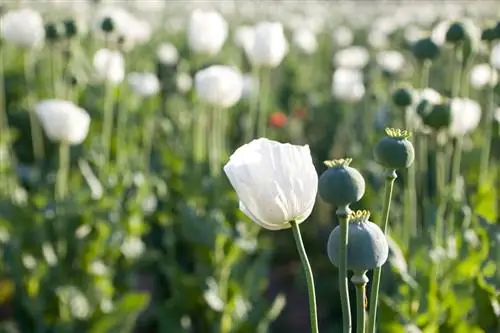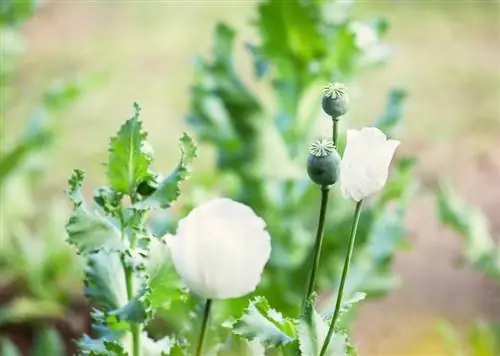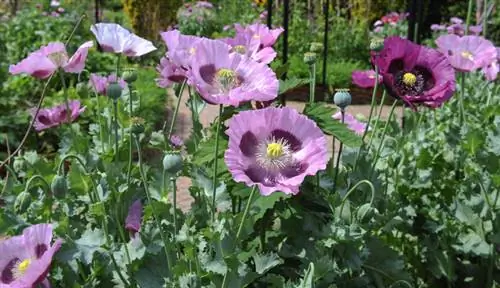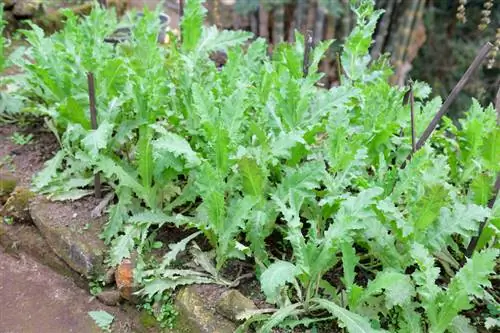- Author admin [email protected].
- Public 2023-12-16 16:46.
- Last modified 2025-01-23 11:20.
In early summer they can be admired again: the bright yellow cornfields with the numerous bright red spots of corn poppies (Papaver rhoeas) and the blue cornflowers. The beautiful, but often not particularly long-lasting, flowers of the poppy can also be admired in numerous gardens. However, you should definitely be careful when choosing suitable varieties, because the cultivation of some poppy varieties - including the opium poppy, also known as blue poppy - falls under the Narcotics Act in Germany and is therefore prohibited.
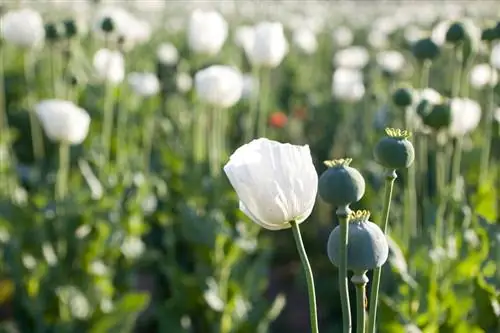
What legal alternatives are there to opium poppies?
Opium poppy (Papaver somniferum) is banned in Germany due to the Narcotics Act. Legal alternatives include Turkish poppy (Papaver orientale), Icelandic poppy (Papaver nudicaule) or Alpine poppy (Papaver alpinum), which are available in different colors and sizes.
The cultivation of opium poppies requires a permit
Opium poppy (Papaver somniferum) and some other poppy species and varieties (e.g. Papaver bracteatum and Papaver paeoniflorum) contain opiates, which is why they are also used to produce opium or heroin. For this reason, the cultivation or planting of these poppy species is strictly prohibited and violations can result in imprisonment and/or fines. In exceptional cases, however, the Federal Opium Office may allow the planting of opium poppies, for example in order to obtain the seeds used as blue or baking poppies.for scientific purposes.
Beautiful ornamental poppy varieties as an alternative
Instead of the problematic opium poppy, however, there are many equally beautiful varieties of ornamental poppy with single or double flowers in different colors. We present the most beautiful ones to you here.
Turkish poppy (Papaver orientale)
The Turkish poppy is a perennial with silvery, hairy foliage. The plant loves humus and calcareous soil and should be planted in a location with full sun. You can propagate the Turkish poppy using root cuttings and seeds.
The most beautiful Turkish poppy varieties
| Variety | Flower color | Flowering time | Growth height |
|---|---|---|---|
| Aladin | strong red | May to June | up to 80 cm |
| Beauty of Livermere | orange red | June to July | up to 100 cm |
| Catharina | salmon with black spots | June to July | up to 80 cm |
| Helen Elisabeth | salmon | June to July | up to 80 cm |
| Marcus Perry | strong orange red | May to September | up to 60 cm |
| Perry's White | white with dark spot | May to June | up to 80 cm |
| Petty’s Plum | dark red with dark center | May to July | up to 80 cm |
| Picotee | white | May to July | up to 90 cm |
| Türkenlouis | red, fringed | May to June | up to 70 cm |
Iceland poppy (Papaver nudicaule)
The Icelandic poppy, which is usually one to two years old, blooms profusely in white, yellow, orange-red or red. The cold germinator grows up to 50 centimeters high and prefers sandy soil.
Alpine poppy (Papaver alpinum)
The cold germinator usually flowers white, yellow or orange and - like many mountain plants - prefers a lean, calcareous and rather dry location with lots of sun.
Tip
The wild-growing corn poppy (Papaver rhoeas) is also ideal for garden cultivation, as it is particularly well adapted to our climate and is also very robust.

